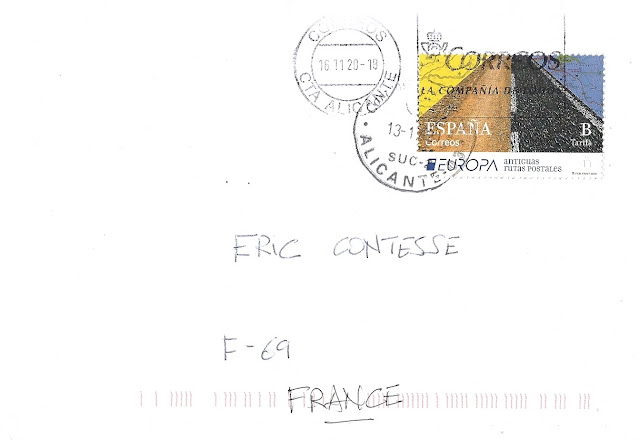Timbre EUROPA 2020 (Anciennes routes postales) sur lettre d'Espagne
Pour illustrer le thème EUROPA des anciennes routes postales ("antiguas rutas postales" en espagnol) choisi cette année par PostEurop, la poste espagnole "Correos" a mis en circulation, le 14 mai 2020, un timbre au graphisme assez surprenant, associant une ancienne route en terre à gauche (avec présence d'une carte ancienne du réseau postal, sur fond jaune) et une route en goudron actuelle à droite (avec présence d'un extrait de carte routière autour de la ville de Cuenca).
Ce timbre (tarif permanent "B" pour un envoi en Europe - 1,45€ actuellement, tirage : 180000), imprimé dans un feuillet composé de 6 timbres (avec une marge supérieure montrant un facteur rural à bicyclette), a été utilisé sur cette lettre envoyée le 13 novembre 2020 depuis la ville d'Alicante. Merci beaucoup Luis !
To illustrate the EUROPA theme of the ancient postal routes ("antiguas rutas postales" in Spanish) chosen this year by PostEurop, the Spanish Post "Correos" put into circulation, on May 14, 2020, a stamp with a rather surprising design, associating an old dirt road on the left (with an old map of the postal network, on a yellow background) and a current tarmac road on the right (with an extract of a road map around the city of Cuenca).
This stamp (permanent rate "B" for a shipment in Europe - currently € 1.45, print run: 180,000), printed in a sheetlet consisting of 6 stamps (with an upper margin showing a rural postman on a bicycle), was used on this cover sent on November 13, 2020 from the city of Alicante. Thank you very much Luis!
Au Moyen Âge, la faible circulation de la correspondance n'a pas réussi à faire disparaître complètement les communications, dont les routes ont été récupérées avec l'expansion des royaumes chrétiens et le développement du commerce et des villes à la fin de cette période.
Pendant la Renaissance, Francisco de Tassis a réussi à articuler le premier réseau postal au niveau européen, ce dont Philippe Ier le Beau a su tirer parti en le nommant maître des postes, établissant ainsi l'une des fondations de la monarchie hispanique.
Le réseau routier s'est ensuite développé et amélioré (routes pavées) à partir de ces routes postales, via des réformes initiées par la dynastie des Bourbons.
In Spain, the oldest postal routes date back to the time of the Roman Empire, which took advantage of the earlier routes (cursus publicus) set up by the civilization of the Tartessos (southern Iberian Peninsula), the Phoenicians and the pre-Roman peoples.
In the Middle Ages, the poor circulation of correspondence failed to completely eliminate communications, the routes of which were recovered with the expansion of the Christian kingdoms and the development of commerce and cities at the end of this period.
During the Renaissance, Francisco de Tassis managed to articulate the first postal network at European level, which Philip the Handsome was able to take advantage of by appointing him postmaster, thus establishing one of the foundations of the Hispanic monarchy.
The road network then developed and improved (paved roads) from these postal routes, via reforms initiated by the Bourbon dynasty.

Aucun commentaire:
Enregistrer un commentaire